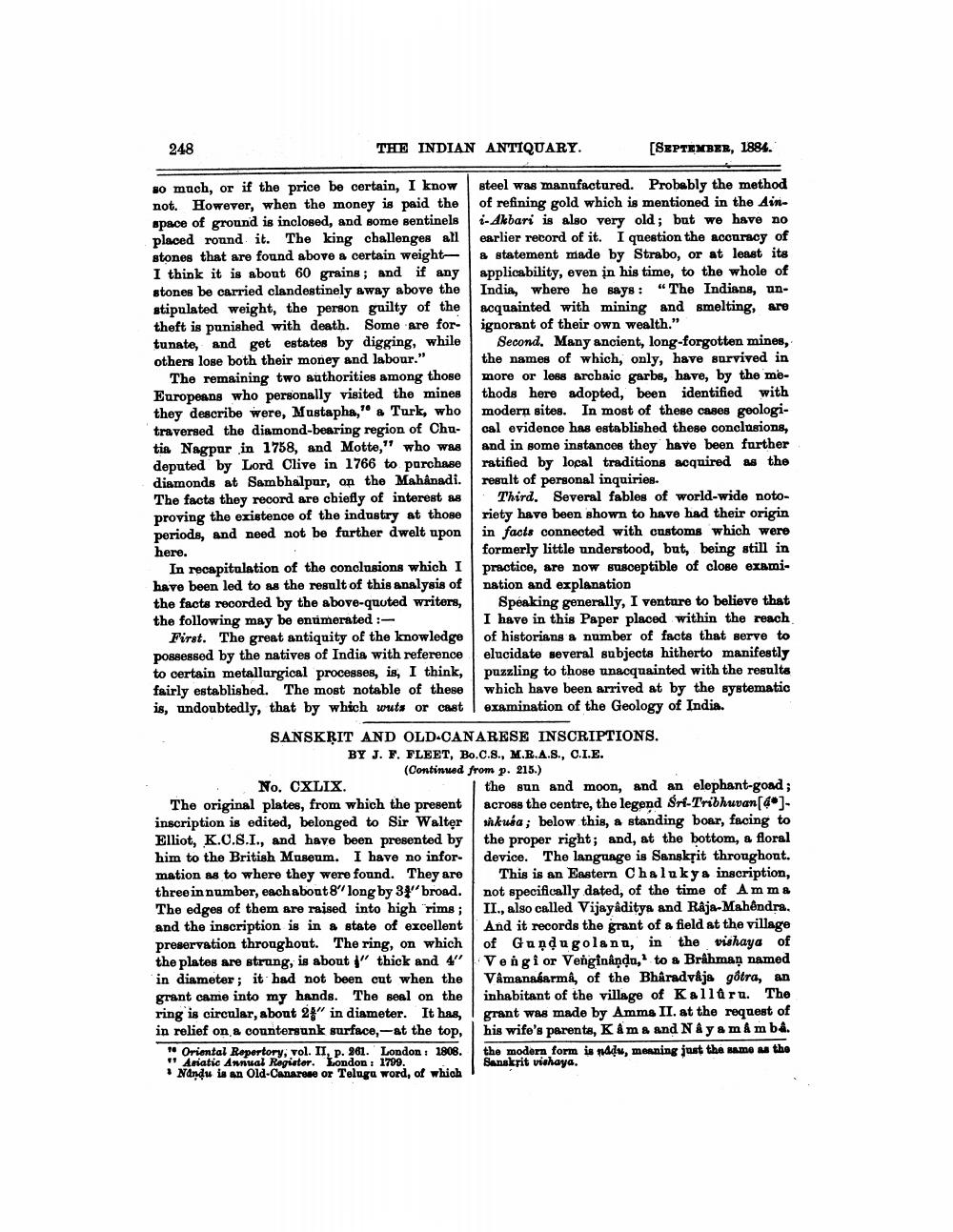________________
248
THE INDIAN ANTIQUARY.
so much, or if the price be certain, I know not. However, when the money is paid the space of ground is inclosed, and some sentinels placed round it. The king challenges all stones that are found above a certain weightI think it is about 60 grains; and if any stones be carried clandestinely away above the stipulated weight, the person guilty of the theft is punished with death. Some are fortunate, and get estates by digging, while others lose both their money and labour."
The remaining two authorities among those Europeans who personally visited the mines they describe were, Mustapha," a Turk, who traversed the diamond-bearing region of Chutia Nagpur in 1758, and Motte," who was deputed by Lord Clive in 1766 to purchase diamonds at Sambhalpur, on the Mahanadi. The facts they record are chiefly of interest as proving the existence of the industry at those periods, and need not be further dwelt upon here.
In recapitulation of the conclusions which I have been led to as the result of this analysis of the facts recorded by the above-quoted writers, the following may be enumerated :
First. The great antiquity of the knowledge possessed by the natives of India with reference to certain metallurgical processes, is, I think, fairly established. The most notable of these is, undoubtedly, that by which wuts or cast
No. CXLIX.
The original plates, from which the present inscription is edited, belonged to Sir Walter Elliot, K.C.S.I., and have been presented by him to the British Museum. I have no information as to where they were found. They are three in number, each about 8" long by 3" broad. The edges of them are raised into high rims; and the inscription is in a state of excellent preservation throughout. The ring, on which the plates are strung, is about " thick and 4" in diameter; it had not been cut when the grant came into my hands. The seal on the ring is circular, about 25" in diameter. It has, in relief on a countersunk surface,-at the top,
[SEPTEMBER, 1884.
steel was manufactured. Probably the method of refining gold which is mentioned in the Aini-Akbari is also very old; but we have no earlier record of it. I question the accuracy of a statement made by Strabo, or at least its applicability, even in his time, to the whole of India, where he says: "The Indians, unacquainted with mining and smelting, are ignorant of their own wealth."
SANSKRIT AND OLD-CANARESE INSCRIPTIONS. BY J. F. FLEET, Bo.C.S., M.R.A.S., C.I.E. (Continued from p. 215.)
Oriental Repertory, vol. II, p. 261. London: 1808. "Asiatic Annual Register. London: 1799.
Nandu is an Old-Canarese or Telugu word, of which
Second. Many ancient, long-forgotten mines, the names of which, only, have survived in more or less archaic garbs, have, by the methods here adopted, been identified with modern sites. In most of these cases geological evidence has established these conclusions, and in some instances they have been further ratified by local traditions acquired as the result of personal inquiries.
Third. Several fables of world-wide notoriety have been shown to have had their origin in facts connected with customs which were formerly little understood, but, being still in practice, are now susceptible of close examination and explanation
Speaking generally, I venture to believe that I have in this Paper placed within the reach of historians a number of facts that serve to elucidate several subjects hitherto manifestly puzzling to those unacquainted with the results which have been arrived at by the systematic examination of the Geology of India.
the sun and moon, and an elephant-goad; across the centre, the legend Sri-Tribhuvan[4]shkuśa; below this, a standing boar, facing to the proper right; and, at the bottom, a floral device. The language is Sanskrit throughout.
This is an Eastern Chalukya inscription, not specifically dated, of the time of Amma II., also called Vijayaditya and Raja-Mahendra. And it records the grant of a field at the village of Gundugolanu, in the vishaya of Vengi or Venginânda, to a Brahman named Vâmanasarma, of the Bharadvaja gotra, an inhabitant of the village of Kallara. The grant was made by Amms II. at the request of his wife's parents, K âm a and Nây a mâm bâ. the modern form is nadu, meaning just the same as the Sanskrit vishaya.




